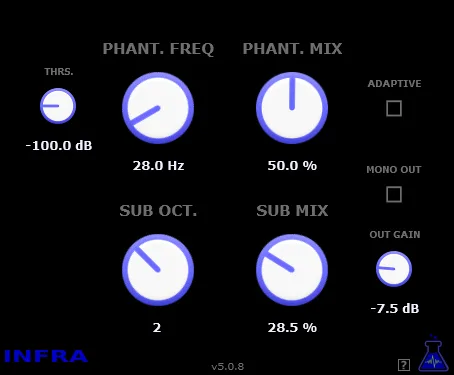Chorus GAS: A New Dimension of Modulation Effects from Stone Voices
The world of sound design and music production is constantly evolving, and plugin developers never cease to amaze with their innovative approaches. The Chorus GAS plugin from Stone Voices is a prime example of such unconventional thinking, offering a unique perspective on classic modulation effects. This is not just another chorus or flanger – it is a tool that opens the door to creating sounds that were previously unattainable within the framework of standard plugins.
Innovative Architecture and Unique Features
At the heart of Chorus GAS lies an original architecture that is significantly different from traditional implementations of modulation effects. Instead of fixed or limitedly adjustable delay lines, this plugin uses four independent delay line modules, each of which can be configured with extreme precision.
MIDI Note Tuning: Harmony in Modulation
The key feature of Chorus GAS is the ability to tune each of the four delay lines to a specific MIDI note. The tuning range covers the full MIDI spectrum from C0 to G10. This function fundamentally changes the approach to creating modulation effects. Instead of simply adding movement and volume through phase shifts and short delays, you can embed harmonic or melodic relationships into the effect itself. This allows you to create modulations that not only thicken the sound but also add tonal “overtones” that correspond to the selected notes. Imagine a chorus that adds light harmonic echoes to your synth pad or vocals, moving in sync with the modulation. This opens up limitless possibilities for experimentation and the creation of unique, harmonically rich textures.
Sound Palette: From Classics to Top Effects
Thanks to the flexible adjustment of delay lines, Chorus GAS is capable of reproducing a wide range of classic modulation effects:
- Chorus: Creating the effect of thickening and expanding sound, simulating the simultaneous sounding of several instruments or voices.
- Flanger: A characteristic “metallic” or “jet” sound, achieved through a short variable delay and feedback.
- Phaser: Creating the effect of rotation and filtering by shifting the phases of the signal.
- Vibrato: Smooth modulation of pitch.
However, the true power of Chorus GAS is revealed in its ability to realize “tonal” versions of these effects. By tuning delay lines to intervals, chords, pentatonic or other scales, you can create effects that simulate:
- Tonal choruses that add harmonically related copies of the signal.
- Harmonic flangers, where characteristic dips and amplifications occur at frequencies related to the selected notes.
- Complex, harmonically controlled modulation textures.
This allows you to integrate the modulation effect directly into the harmonic context of your composition, creating new, unexpected sounds.
Filtering Features in the Feedback Loop
Another distinctive feature of Chorus GAS is the presence of an adjustable high-frequency filter (High-Pass Filter) in the feedback loop. This filter plays an important role in shaping the final sound, especially when using feedback. It allows you to:
- Prevent the accumulation of low frequencies and “clouding” of the sound at high feedback levels.
- Give the sound a special “flavor” and character, emphasizing high-frequency harmonics.
- Create a feeling of lightness and “flight,” as the developer mentions, thanks to control over the lower part of the spectrum in the feedback loop.
This function adds an additional level of control and possibilities for fine-tuning the effect, making it an even more versatile tool for sound design.
Creative Potential and Applications
Chorus GAS is a valuable asset for any music producer, sound engineer, or sound experimenter. Its unique capabilities make it ideal for:
- Creating rich, evolving pads and textures on synthesizers.
- Adding harmonic saturation and unique modulation shades to vocal parts.
- Processing guitars and basses to obtain new, unexpected tonal effects.
- Experimenting with drum and percussion sounds, adding rhythmic tonal delays.
- Creating atmospheric effects and special effects for films, games or audio installations.
The ability to integrate harmonic relationships directly into the modulation effect opens up completely new horizons for creativity. You can use Chorus GAS as a regular modulation plugin, or delve into its deeper functions, creating truly original and expressive sounds that will distinguish your tracks from others.
Technical Details and Compatibility
The Chorus GAS plugin is distributed in the VST format, which makes it compatible with the vast majority of modern digital audio workstations (DAW) on the Windows platform. Both 32-bit (Win32) and 64-bit (Win64) Windows operating systems are supported, ensuring wide compatibility for users of this platform.
Conclusion
Stone Voices Chorus GAS is more than just a modulation effect. It is a powerful and innovative tool for sound design that offers a unique opportunity to integrate harmonic principles into the modulation process. Its ability to tune delay lines to MIDI notes, combined with the flexible HPF in the feedback loop, makes it indispensable for those who are looking for fresh, non-trivial sounds and want to expand their palette of effects. If you are ready to go beyond the usual choruses and flangers and explore the new dimensions of tonal modulation, Chorus GAS definitely deserves your attention.



